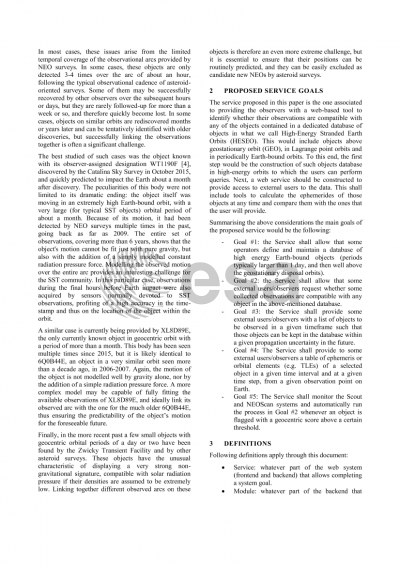Document details

Abstract
A large number of NEO observers provide observations of moving objects to the MPC database. Those observations are used by several systems (like NASA’s Scout or the European NEOScan systems) for identification and early warning of ‘imminent impactors’. These systems use the information on the MPC NEO Confirmation Page (NEOCP) and evaluate all possible orbital solutions compatible with the small amount of available observations.
In the event of an Earth-orbiting object (space debris or satellite, in the domain of SST) being observed, and due to this unavoidable poor accuracy of the initial estimated orbit solutions, both geocentric and heliocentric orbits are often compatible with the data. In this situation, some of those objects may be considered potential NEO close approachers or imminent impactors. This case has occurred recently in several occasions, such as with the small artificial objects ZTF00Y5 and ZS0BB63.
In order to avoid the identification of these objects as false imminent impactors, there is a need for NEO observers to quickly identify if their observations map to some known SST object, ideally before sending information to MPC, or at least notify the MPC and the community that some observations are compatible with a known artificial object. The same process should be routinely applied to objects already on the NEOCP but flagged as having a non-zero chance of being in Earth orbit, to make sure no obvious identification with known man-made objects has been missed. In order to reach this goal, several approaches are possible.
A first option can be based on using available SST objects catalogues to allow observers to identify these correlations themselves. This option is partially possible, and can be based on public SST catalogues as the American TLE dataset. However, this approach has several drawbacks, among them the lack of completeness of the public catalogues. In addition, the need of SST-specific knowledge and/or tools may be an obstacle to the use of these tools for some NEO users that are not used to handling data in the SST domain.
The other option may be the development of a service to which observers can provide observations and receive a confirmation whether they correlate to any known SST object. This service could be based on a TLE catalogue, or any other data source, maybe maintained by other SST systems different to the American JSpOc one.
An additional type of support from the SST community can be envisaged in the form of availability of SST telescopes in the case a follow-up of some of those objects is needed. Suitability of those telescopes is larger than that of the NEO community due to the adaptation to the higher angular velocities. In order to allow this kind of support, several aspects shall be addressed, namely: observation approaches, data formats, data processing pipeline suitability, corrections to be applied, timeliness for tasking response, etc.
The benefit for the SST community from this support is to get observations from some objects which are unlikely to be observed and maintained by the SST surveillance systems, as they orbit in regimes at higher altitudes than those nominally monitored. This paper evaluates the current situation, details the needs of the NEO field, and summarises the requirements and interface issues of such kind of services that the SST community can offer to support the NEO community. The particular case of the correlation service offered by ESA’s SCOOP system is analysed, in order to identify the suitability for the solution of this problem, and the required upgrades needed to allow its use in the NEO community.
Preview






